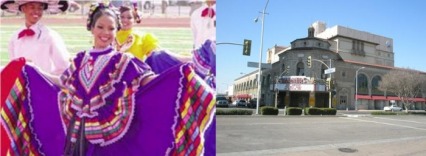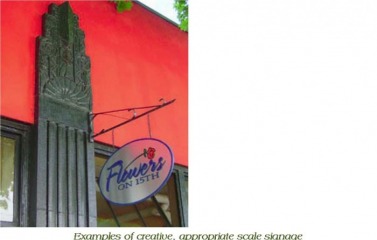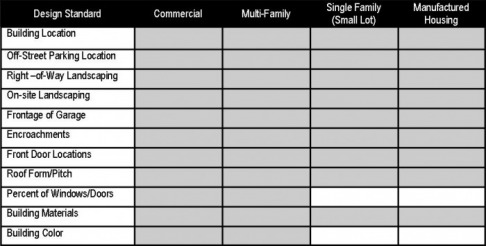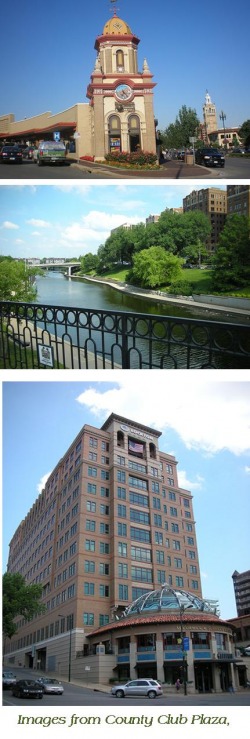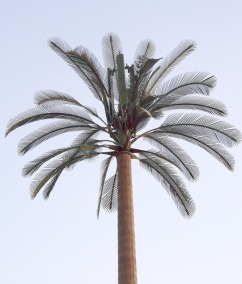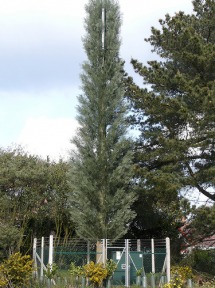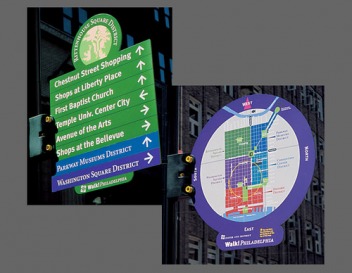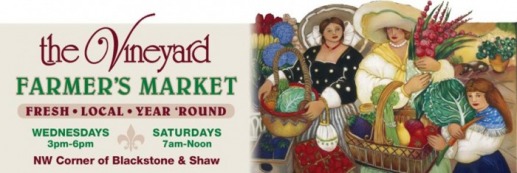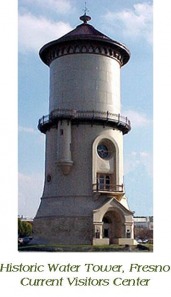
Demand is growing for town centers, commercial corridors, public plazas and transit villages that create a sense of place and establish a unique identity for a community. Developers and builders are finding that tenants and homebuyers are willing to pay a premium to live in a neighborhood that is attractive, pedestrian-oriented and creates a sense of community.
In response, towns and cities are looking to develop more of the types of places that their residents can take pride in – the shopping districts and plazas where residents bring out-of-town visitors and frequent on the weekends, or well-designed, pedestrian-oriented gathering places that focus on historical, cultural or natural attributes – while creating opportunities to pursue a range of activities in a small area. Many existing communities have such features, and new developments can be designed to create central gathering places and areas of civic pride. By preserving and maintaining the buildings and natural environments that make our communities unique, we are creating places of lasting value that serve as focal points for the current community and future generations. Historically, the public and private sectors have each played a critical role in creating attractive and memorable places.
Sustainable growth supports the idea that development should not only respond to the basic commercial or housing needs, but should also help to create communities that are distinctive and unique. Sustainable growth seeks to foster the types of physical environments that create a sense of civic pride, and therefore support a more cohesive community fabric. As a result, economic benefits accrue as well; high-quality communities with architectural and natural elements that reflect the interest of all residents are more likely to retain their economic vitality and value over time.
Communities that have a strong sense of place represent the values of their residents and reflect the unique historical, cultural, economic, and geographical context of the area. They use natural and man-made boundaries and landmarks to create a sense of defined neighborhoods, urban communities, and regions. These communities encourage the construction and preservation of buildings, which prove to be assets over time, not only because of the services provided, but also because of the unique contribution they make to the look and feel of a community. Beyond the construction of buildings, these communities reflect their unique characteristics in myriad details; landscaping, signs, awnings, which help to further distinguish the area for passers-by and visitors. Guided by their own vision of how and where to grow, communities that have adopted sustainable growth principles can direct investment and development into areas that already reflect a strong sense of place. Moreover, these communities can encourage new fringe development to make a better effort to create distinctive unique civic assets.
In the quest to improve conditions in urban, suburban and rural communities, citizens are becoming ever more engaged with elected officials and government agencies in public processes. These lively forums, which weigh special interests against the broader public concerns, often generate heated debate among permit applicants and the public officials charged with enforcing laws and synthesizing solutions.
One common thread that allows an effective discussion of such issues to occur is the shared interest among all stakeholders in the creation, conservations, or enhancement of a community’s particular character. The character evolves from the weaving together of many elements to create a sense of comfort, function, and attractive appearance. Summarized below are five elements that help establish a community’s unique sense of place.
Natural Features and Systems
In a sense, every city is simply an extension of the natural landscape upon which it is sited. This landscape is composed of watersheds, aquifers, and geologic formations and may be part of a rich rain forest or an arid desert. Consideration of the natural setting is essential in every decision a community makes about how it should build.
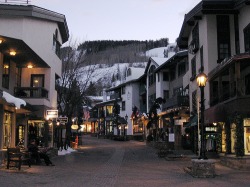
Vail, Colorado
In some cases, the natural setting is intrinsically linked to an area’s community character and in fact defines a key aspect of its economic vitality. This fundamental relationship is reflected in many of the country’s most popular resort towns such as, Hilton Head, along the Atlantic Coast of South Carolina; Sedona, in the Arizona desert; and Vail, in the Rocky Mountains of Colorado.
In other cases, the protection of natural resources comes out of a planning process that identifies a range of assets that need to be protected or restored. In Portland, Oregon a participatory process led to the adoption of a comprehensive plan affirming that every citizen should have a view of Mount Hood. Having identified this major, natural feature as a community asset, the city established protective view corridors that, in turn, guided the heights of new buildings and shaped Portland’s urban form.
The Public Domain
Paragraph.
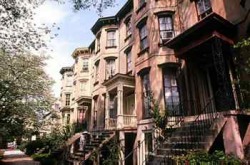
Historic District, Savannah Georgia
In terms of a place’s physical elements, it is through streets, sidewalks, and public spaces that public officials have the greatest opportunity to directly create and conserve the cityscape in a manner that contributes to a community’s overall quality of life. A case in point is the historic district in Savannah, Georgia: its urban grid, square, and sidewalk design are stellar examples of how a pedestrian-friendly city should work from front door to street edge. Streets are organized around a clear system of squares that create public destinations and unique identities within the historically rich districts. The sidewalks maintain one level for the public’s movement and then shift up slightly to form a continuous landing for either stairs or street-level doors, thus transitioning elegantly and effectively among public, semipublic, semiprivate and private zones.
In addition, one of the best ways that the public sector can assist in the enhancement of a city’s character is to strategically place and contextually develop its own building projects. Cities and counties have the opportunity to set the standard for public parks and institutions, including libraries, schools, fire and police stations, and the public spaces which adjoin these structures. In all cases, the placement and design of such new elements should conserve and support the existing natural and historic features of the place.
Historic Preservation
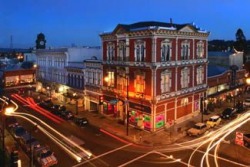
Preservation of Historic Peteluma, CA
In many U.S. cities, the first “urban design” policies even enacted were those for historic preservation. Far from being an impediment to revitalization, historic preservation has proven to be one of the best tools given to public officials to preserve a neighborhood’s sense of place and then to leverage that authenticity for new investment, tourism, and sustainable growth. Many cities have identified what is valuable about a particular place and have established development regulations, including those that restrict demolition and encourage sensitive rehabilitation, to ensure that place-defining buildings will be maintained for future generations.
While people often associate historic preservation with the rescue and restorations of a single landmark building, the broader application of historic designations over entire districts has been key to the successful urban revitalization of many cities. Historic designations of several districts in Charleston, South Carolina preserved what is one of the world’s most engaging urban designs, but also protected individual properties until economic forces aligned to reinvest in the area.
Pedestrian Scale
The use of the word scale simply addresses whether a built feature is sized appropriately for its location and how it will be experienced. From the sidewalk widths to building heights, size does matter in the creation of places that make us feel comfortable. To appreciate this, consider the experience of walking along sidewalks that are too narrow to feel safe near zooming cars or along endless blocks of wall that generate unpleasant feelings because of their severe monotony.
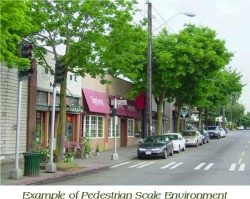
Wherever pedestrian scale needs to be championed, its adversary is usually the automobile, or more appropriately, the typical design response often engendered by development regulations that place motorized vehicles at the top of the user hierarchy. As a rule, we should ensure that every pedestrian experience is a positive one, no matter the local climate. The can vary from tree-lined streets in temperate zones to ample continuous-built canopies in an arid area. The guiding principle is that paths along which people move – whether sidewalks, bike paths or trails – should feel safe, engaging and appropriate for the climate so that pedestrians feel comfortable along the route.
Another guiding principle for pedestrian scale is that the public places we create should be as comfortable for one person as for many. Parks should have spaces and paths that invite and functionally support multiple activities and audiences – from an individual sitting alone to hundreds attending a large event.
Signage
Even with the clearest design and most coherent development, signage is needed to direct people through their communities. Signs may be used on private commercial property to locate businesses or to advertise the products and services they sell. Signs may also be used in the public domain to direct pedestrians, identify historic and entertainment districts, and to point out cultural institutions. Of course, no community can function without the basic signs of traffic management, from yielding rights of way to identifying parking spaces and garages.
Taken as a whole these various signage components play as important a role as any other architectural or urban-design element. Signage scale, style and sometimes even context should be guided by local context. The neon billboards and 40-foot-tall signs that work so well along the strip in Las Vegas would not be fitting on Shaw Avenue in Fresno County.
As public agencies grapple with enforcing codes while also encouraging quality development, it is important to balance commercial interests with design guidelines that enhance the positive attributes of a place. Signage must be seen as an integral design component and not as an after-the-fact add-on to a community’s design.
Encourage preservation or adaptive reuse of historic, architecturally significant or blighted buildings
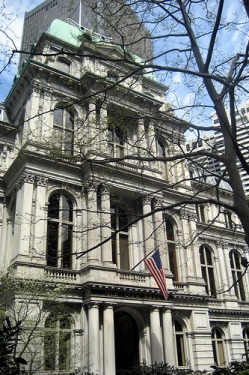
Old City Hall, Boston
Well-maintained historic, culturally, or architecturally significant buildings are often regarded as some of the most valued civic treasures in a community. These buildings remind residents and visitors of an area’s unique history and provide a visible link to it. While historic buildings often do not retain their original use, their adaptive renovation and reuse can create unique, interesting, innovative spaces for modern services. When clustered in close geographic proximity, these buildings can create the basis for a specially designed zone or district that may attract tourism and other appropriate economic development activities. Finally, the very existence of historic or architecturally significant buildings may provide the basic building blocks for recreating a pedestrian-oriented development.
Revitalized buildings, both commercial and residential, are a key element in maintaining the sense of place for a community. A reused building keeps its place in the community, revitalizing a neighborhood and retaining the character and livability of the area. Abandoned or blighted buildings drive down property values, create an atmosphere of economic decline and hopelessness and invite crime. Reusing these buildings maintains the character of our cities and boosts civic pride. These buildings also provide a visible link to a community’s unique history.
Another important advantage of adaptive reuse is environmental. When a building is saves and reused, much of the energy and resources in the original construction; such as labor, materials, fabrication, and transportation can be saved. Adaptive reuse of historic buildings requires fewer construction materials but often requires more time in labor. This means that, although reuse may be more expensive than new construction (thus the reasons for incentives), a renovation project can provide more jobs for local tradesmen then a new construction project. Preservation of environmental heritage and archeological elements such as significant old trees and other natural objects as well as archeological sites should also be encouraged if they add to the identity of the community.
There are a number of incentives to reuse historic buildings. Commercial property owners who choose to renovate their historic buildings and follow certain historic preservation guidelines are eligible for a federal tax credit equaling 20 percent of the cost. A 10 percent credit is available to non-historic commercial buildings more than 50 years old. State tax credits, modeled after the federal program, are a possible action for states to support historic preservation. Through state tax credits, incentives can be created for localities and developers to engage in public-private partnerships to convert buildings to new uses. With creative thinking, effective partnerships can turn historic theaters into arts centers or retail spaces, and can renovate small factories as loft apartments or business incubators.
Performance zoning is another tool for adaptive reuse, especially of blighted commercial properties. Performance zoning is based on outcomes, not prescriptions. Whereas traditional land use zoning specifies what uses land can be put to within specified districts, performance zoning specifies the intensity of land use that is acceptable. In other words, it deals not with the use of a parcel, but the performance of a parcel and how it impacts surrounding areas. Performance zoning allows a wide range of uses on commercial property, but holds the property owner accountable though performance zoning standards to control factors such as noise, odor, traffic, vibration and exterior lighting.
Establish revolving loan funds for historic preservation
Historic sites and buildings play a valuable role in educating new generations about the nations’ culture and heritage. Many of these places are unique and revered features in their communities. Often times, funding for the preservation of historic properties, neighborhoods, and landmarks competes with budgetary allotments for libraries, parks, and other public amenities. Sometimes, preservation funding comes from a state program whose budget fluctuates from year to year and makes investing in the restoration and rehabilitation of structures less predictable and reliable.
To ensure adequate and sustained funding for historic preservation, some communities and preservation foundations are establishing revolving loan funds. Frequently, these funds are capitalized with an initial grant or with proceeds from a bond measure. Loans are made to nonprofit organizations and local governments, and are dispersed with favorable interest rates and 10- to 20- year repayment terms. The principal and interest are then returned to the loan fund for continued historic preservation. By creating revolving loan funds, communities have more assurance that funding for historic preservation will be available despite changing economic tides.
Enact clear community design guidelines so that streets, buildings, and public spaces work together to create a sense of place
Developing design guidelines that foster a unique sense of place is a multifaceted process that first must educate and involve the community. Community planners can invite the public to community design workshops where residents, business owners, developers, and officials are introduced to the benefits of good design. Town planners, landscape architects, historic preservationists, developers, and architects present design principles that can protect, enhance, and maintain community character.
Beyond basic requirements for safety and accessibility, buildings are often subject to little regulation on how they look, how they are constructed, or how they related to the street. In the absences of such requirements, few developers find it in their financial best interest to invest in architectural detail or decorative features, which would enhance the look of buildings and would contribute to a more distinctive and appealing community. The same could be said of public officials who, in the construction of civic buildings, sidewalks, streets, and public parks, are motivated primarily by the desire to deliver the necessary product at the lowest possible costs and in the shortest time possible. It is precisely the cumulative effect of these numerous individual development and design decisions that create the look and feel of our built environments.
Communities that include well-designed buildings, attractive signage, well-maintained facades, and a positive orientation of buildings to the street are often the most distinctive. Other opportunities for improved design guidelines pertain to the placement of bus shelters and benches, the design of sidewalks and bike paths, the introduction of landscaping and street trees, and the incorporation of community parks and public gathering spaces. With improved attentiveness to these aspects, communities are more valued for their uniqueness, better able to attract new business and residents, and therefore less likely to suffer disinvestment and neglect. This ongoing vitality of neighborhoods is both an outgrowth of and a contributor to sustainable growth.
As a community established its own definition of a desirable look, an opportunity arises to create a unique, memorable streetscape to attract future development. These preferences can form the basis for the creating of clear design guidelines that regulate building setback, street and sidewalk design, architectural styles, signage practices, and building materials. The guidelines can be prescriptive and detailed, regulating everything down to the size and color of signs, or they can set broad parameters for design to allow or maximum diversity among users. In either case, when they are applied in a clear and consistent fashion, these design considerations add value to the community and provide guidance for developers who, in turn, can create higher quality projects by being attentive to their end design from the early stages.
The table below shows the possible application of various design features to certain building types and uses for land development regulation:
Make retail centers distinctive and attractive destinations
In many places, stores are housed in cookie-cutter regional malls surrounded by surface parking or can be found in strip malls that appear at regular intervals along busy arterials. Increasingly, these developments are failing. While shopping continues to be a great American pastime, people are looking for new, more attractive places to shop. In response, retailers have been locating stores on older main streets ad in “lifestyle centers” – open-air shopping malls that are located in town centers. Today’s attractive and successful retailing centers pay careful attention to the pedestrian experience. They also capitalize on interesting architectural design to attract both retail tenants and surrounding office and residential development.
The Country Club Plaza in Kansas City, Missouri constructed in the 1920’s, offers many lessons for contemporary retail design. This low-rise landmark is a pedestrian-oriented, open-air market designed with Spanish-style architecture and adorned with public art, plazas and fountains. Next to the historic market, a 60-acre business district evolved over the decades to provide jobs for the residents in the high-density apartment blocks surrounding the area and to create stronger market demand for the plaza’s commercial development. In 2003, the plaza celebrated its 80th birthday. It still endures as a shopping destination even as additional retail, office and parking projects have been added to the original center. The building’s innovative design and high-quality construction have ensured that the shops stay leased with retail outlets and services. While the tenants have changed over the years, the plaza is still a central gathering spot for locals and tourists alike.
Creating attractive retail is a viable business strategy for developers and a boon for the residents and consumers who shop there. The project becomes more than just a place to buy good, it becomes a centerpiece for the community.
Simplify and expedite permitting regulations to allow vendors to offer sidewalk services
Facilitating sidewalk service (e.g. walk-up window purchases, retail displays, dining and kiosks) is perhaps the easiest way to provide support for expanded business along pedestrian-oriented commercial thoroughfares. By allowing vendors to sell their good and wares at walk-up windows or at kiosks placed along the sidewalk, local governments make it easier for entrepreneurs to connect with their customers, and sidewalk service creates a magnet for strolling shoppers who seek an alternative to the local enclosed mall. The increased foot traffic that results will spur more business investment and crate a vital neighborhood shopping area from which the entire community can benefit.
In many cases, permits for sidewalk service are either difficult to obtain from local governments, or the permits require a complicated approval process. Local governments, in cooperation with local business leaders, can target neighborhood shopping districts, identify the type of retail activity that would complement existing businesses, and then simplify and expedite the permitting process accordingly. Communities that are seeking to expand sidewalk service should also ensure that the designated sidewalks are wide enough to accommodate a higher level of activity.
By coordinating efforts among zoning, licensing, and public works officials, potential vendors benefit from an expedited approval process, and the jurisdiction benefits from growth in sales tax receipts and permitting fees associated with new business start-ups. Most importantly, communities benefit from a vibrant, strong, pedestrian-oriented shopping district that can provide a focal point for activity and neighborhood identity.
Create special improvement districts for focused investment
The designation of special districts is a convenient means to organize and focus investment in a particular area to achieve a range of outcomes, such as historic preservation, business improvement, or economic revitalization. It provides an opportunity for local or other special purpose governments to establish clear boundaries and names for geographic areas with which residents and businesses can better identify. By strengthening the sense of community in these areas, citizens can become more involved in development decisions about their own district and the region of which it is a part.
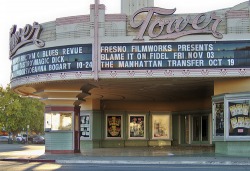
Tower Theater, Tower District Fresno
Creating fixed boundaries around neighborhoods in which tax incentives, regulatory flexibility, or other financial benefits are made available can help channel targeted investment to support strong, vibrant communities. In central business districts, business improvement districts coordinate shared responsibility among businesses and building owners to support entertainment, services, or other amenities that can attract customers and improve the business climate. Historic districts are used to help protect tracts of historic buildings through the provision of tax incentives or grants for restoration and preservation. Support to designated art corridors may help attract a critical mass of artists, suppliers, and vendors, which would constitute a destination in itself for art lovers. Neighborhood centers often benefit from a clear determination of the service area around the center in order to better identify potential customers and recruit businesses and service providers accordingly. In these and other cases, creating smaller-scale zones within a larger urban or suburban context can help residents, visitors, and businesses better identify communities by their stronger sense of place.
Modify state funding processes and school siting standards to preserve neighborhood schools and build new schools to a “community level”
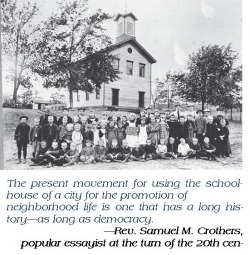
Neighborhood schools are those that serve the educational needs of nearby residents and that contribute to the social and physical environment of the community. Neighborhood schools function as community gathering places for adult education programs, evening civic events, or weekend sports competitions. They may serve as landmarks in a community or as examples of monumental architecture or historical significance within a region. Schools built at a community level are constructed to complement existing neighborhoods and provide improved walking or bike access to the school by students and community members. Schools serve as critical civic anchors in a community. Schools are often the center of districts or neighborhoods with which residents can identify.
Siting standards and funding criteria common in many states present significant obstacles to communities wishing to support neighborhood schools. Current standards typical in most states require vast tracts of land for new construction. These standards often leave communities with little choice but to build schools an available land on the urban fringe. These school located on the urban fringe are then forced to accommodate a large number of vehicles used for transport of its students. State standards often require new construction if renovation costs to existing structures exceeds a threshold amount. Providing for schools in a manner that fosters their incorporation into the surrounding neighborhood is an important aspect of sustainable growth. Through modified siting and funding criteria, state can better support localities that want to maintain existing schools and ensure the responsible placement of new schools. Strategies such as the use of shared-risk insurance plans, can help overcome the liability obstacles that often prevent schools from more fully serving as community gathering points for after hour activities and events.
Define communities and neighborhoods with visual cues
Just as the ancient city wall once indicated to people the beginning of a tow, visual cues are an important means to help visitors and residents distinguish areas from one another. Often subtle, sometimes blatant, these cues act as either focal points or way-finding aids to attract and direct pedestrian and automobile flow to commercial or entertainment activities. In so doing, cues create virtual borders around districts for special uses, give shape and definition to neighborhoods, and contribute to the unique look and feel of a given community. Communities that are well-defined and easy to navigate not only attract new activity and investment, but they help create neighborhoods and amenities that are worth preserving.
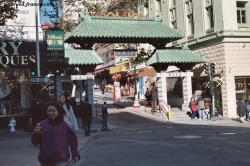
Chinatown Gate, San Francisco, California
Cues can be explicit, such as signs directing visitors to important locations or monumental-type architecture, which contributes to the vista at street ends or along blocks. The decorative gate in Chinatown, San Francisco, is a clear example of this sort of physical introduction to a unique and distinct community. Visual cues can be more subtle and include elements such as unique lightposts, novel street signs, variegated materials for streets or sidewalks, distinct landscaping styles, or complimentary awnings or overhangs above businesses. Open space and natural features such as greenbelts, creeks or other prominent natural features can be used to introduce or signal the transition from one zone to another.
As with policies to achieve distinctive communities, visual cues can be incorporated into new and existing communities through the combined efforts of the public and private sectors. The preferences articulated by communities for aesthetic details are codified and enforced in building codes and design standards and preferences for the placement and orientation of open space and monumental buildings
Create active, secure, community open spaces
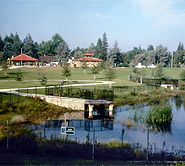
Oso De Oro Park, Fresno County
Open spaces, whether built or natural, active or passive, help create distinctive communities. In older cities and towns, there is often a critical need for safe, recreational green spaces for city residents. Pocket parks, playgrounds, plazas, squares, social gathering places, and other publicly accessible open spaces contribute to the aesthetic quality of the surrounding area and to the feeling of “community” which fosters a strong sense of place. Open spaces also provide environmental benefits as hosts to trees and penetrable ground surfaces that filter air and water, and mitigate stormwater runoff. These spaces must be managed and designed in a way that ensures the safety of their users so that the public spaces remain viable and desirable over time.
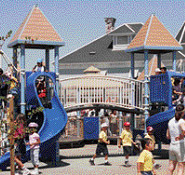
Trolly Creek Park, Fresno
Many opportunities exist to foster open space in a community. Open spaces can be created through incentives to developers, through direct construction by local governments, or through other private-public partnerships. In new developments, open spaces should be incorporated into the design process and placed in a manner that ensures maximum access and use by area residents. In existing neighborhoods, street ends, abandoned lots, brownfields or deteriorating houses may provide opportunities for small, scattered parks or community gardens. In bustling commercial centers, plazas, parks and public squares can serve as prominent amenities for employees and shoppers while adding value to nearby buildings. Each of these settings can also serve as a venue for engaging the public in festivals, community gardening activities, sports events, or other civic activities that help to galvanize the sense of community among members, and create places in which people have a vested interest to preserve and to protect.
Community parks can be established voluntarily by households located adjacent to vacant or blighted areas. Residents can also apportion parts of their backyards into a larger shared yard or garden space. They can also work with city government to transform neglected alleys into useable green space. Local governments can encourage residents and/or nonprofit organizations to create community open spaces through matching grants, low-interest loans, design services, fence removal, and free or low-cost plant supplies.
.
.
Plant trees and other native vegetation throughout communities and encourage the preservation of existing trees during new construction
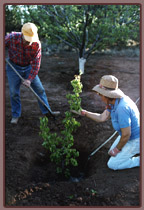
Tree Fresno Volunteers
Trees and vegetation play important environmental, aesthetic, and economic roles in creating distinctive and healthy places to live. Trees and vegetation along medians, sidewalks, and embankments serve to filter noise and pollution from nearby vehicular traffic. They as mitigate erosion that causes damage to and raises maintenance costs on adjacent roadways. Along commercial and residential zones, trees provide a canopy of shade and shelter from the elements, and soften and frame the streetscape for the passerby. Large trees along retail strips make the strip more inviting, which generates more business, thereby serving as an economic stimulus for the community. By cooling homes and communities, trees reduce energy costs and create a more comfortable climate for outdoor activities. By slowing stormwater runoff and helping to protect wetlands, trees can reduce the costs associated with water treatment for local jurisdictions. They help the environment by cooling temperatures and by consuming excess carbon dioxide. In short, trees add to the beauty, distinctiveness and material value of neighborhoods by incorporating the natural environment into the built environment.
Through collaborative efforts, neighborhoods and the public and private sectors can be engaged to preserve and add to the tree and vegetation stock in a community. In existing communities, tree planting programs undertaken by schools and civic associations can increase the presence of trees on residential streets and commercial thoroughfares. Education programs can be developed to assist property owners in the care and maintenance of their trees and vegetation. Professional foresters, horticulturists, arborists, landscape architects and planners can donate time and experience to ensure that these programs are founded on good information. Volunteer planting and maintenance programs can be established which assist property owners who are elderly, disabled or financially burdened. Incentives can encourage land owners to protect their trees and to improve their communities. Incentives for promoting tree preservation include, but are not limited to:
- Establishing a community grant fund for replacing or planting new trees
- Offering developers zoning incentives such as reduced setbacks or increased density in exchange for tree preservation
- Giving property tax breaks to landowners who agree to preserve their woodlands
Preserve scenic vistas through the appropriate location of telecommunication towers and improved control of billboards
Extending high above rooftops and trees, telecommunication towers and billboards often dramatically affect the appearance of communities. They clutter the view of an otherwise scenic roadway or streetscape or obscure the natural or physical features of a community altogether. Many creative alternatives exist for the placement of wireless towers such as placing them on rooftops, where they can be concealed by high-reaching building details. Communities that are pressured into creating full and fast access for telecommunications infrastructure may not fully consider these options. Communities can regulate the placement and use of towers by working with private industry to generate ideas on how to locate towers and monopoles unobtrusively. Joint private-public efforts may include agreements to keep tower height equal to the nearby tree canopy, to locate towers on downslopes rather than summits to reduce visual impacts, to limit towers along ridgelines, or to incorporate them into existing features such as water tanks, electric-transmission towers, or church spires. Documenting these guidelines in ordinances that clearly spell out the community’s requirements for tower location, appearance, and design can improve the process of expanding telecommunication networks for all involved.
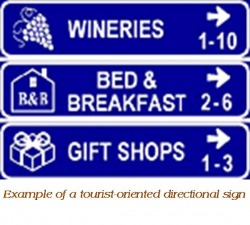
Billboards also present an opportunity for improved management. Communities seeking to preserve their scenic vistas can begin by instituting a moratorium on all new billboards and then encourage the gradual phase-out of existing billboards upon the expiration of leases. Incentives may be created in the form of tax abatements or scenic easements to reward landowners who require removal of billboards from their property upon lease expiration and who keep their property free of billboards. Communities that have been successful in limiting or eradicating billboards in favor of logos signs and tourist-oriented directional signs have created a higher quality of life for their residents and have continues to grow their economies based on their enhanced visual appeal to visitors.
Develop a comprehensive wayfinding system in town centers
Whether a newcomer, a tourist, or a long-time resident, “wayfinders” not only help people find which direction they need to go to get to their destination, but they can also connect people to local history, unique neighborhood features and attractions, as well as the nearest transit stop. To be successful, wayfinding signs must work for both motorists traveling at fast speeds and the slow-moving pedestrians who may be exploring sites along the way. They must organize a large amount of information in visually simplistic ways with consistency in size, graphics and color.
Designers of wayfinding systems use the signs as opportunities to promote the divers activities in the city. In many downtown areas, chamber of commerce and business improvement districts are discovering that wayfinding systems can increase attendance at featured venues. Pedestrians are often willing to walk farther if direction information is available and easy to understand. Wayfinding systems are about more than getting from point A to point B: they create an identity for the city, bring new visitors to attractions, and make it easier for people to get acquainted with the town.
Create opportunities for community interaction
Communities are defined by more than the physical and natural elements that comprise them. The most well-designed street in the world will fail to evoke a sense of community if there are no opportunities for interaction or vibrant exchange among neighbors. Public places of all sorts can provide the venue for these sorts of interactions: sidewalks become hosts to outside shopping or art displays, closed-off streets become havens for block parties or markets, and parks and plaza become open-air theaters for music or performances. Offered on a regular basis, festivals that celebrate local produce, historical events, or cultural traditions can become a vibrant and ongoing reminder of the unique nature of a given community, and can create opportunities for distinctive traditions from which all residents and visitors can derive enjoyment.
Broad constituencies benefit from such events and can be tapped to support farmers’ markets, are and music festivals, or even block parties. Business owners benefit from the increased flow of people attracted by these events. School may support such activities because of the learning opportunities they present to students and as a means to share with the broader community the skills and talents of their children. Local farmers, artisans, and musicians are likely to play a critical role in supporting such events as these events provide outlets for performances and sales that would otherwise be unavailable to them. In many communities, nonprofit organizations are formed with the support of local government and civic leaders to manage and promote these events. Chambers of commerce, economic development agencies, civic associations, and other local organizations can play an important role in bringing together the diverse parties that are necessary to make these events vital parts of the community landscape.
The arts can also be an essential way of establishing a sense of place in a community. Whether through public sculptures woven into the streetscape, murals on building walls, or galleries sponsoring neighborhood walks, the arts bring vitality to urban areas in large and small towns alike. Art-related activities create a broader sense of community in neighborhoods and connect them to other places.
Use distinctive public transit to increase the attractiveness of neighborhoods
Transit is not usually thought of as a tool for creating a sense of place, but in cities like Boulder, Colorado, and Portland Oregon, new bus and streetcar systems are creating distinctive and unifying links in neighborhoods. In these places, the transit systems are designed to reflect the character of the neighborhoods, each with a unique identity and amenities.
A wide variety of resources and programs are available to help the San Joaquin Valley region expand its possibilities to foster distinctive, attractive communities. The following listing contains relevant programs, resources and contacts for technical assistance, financial tools and specialized expertise available locally, as well as at the state and national level.
§ List here (to be inserted at a later date)


